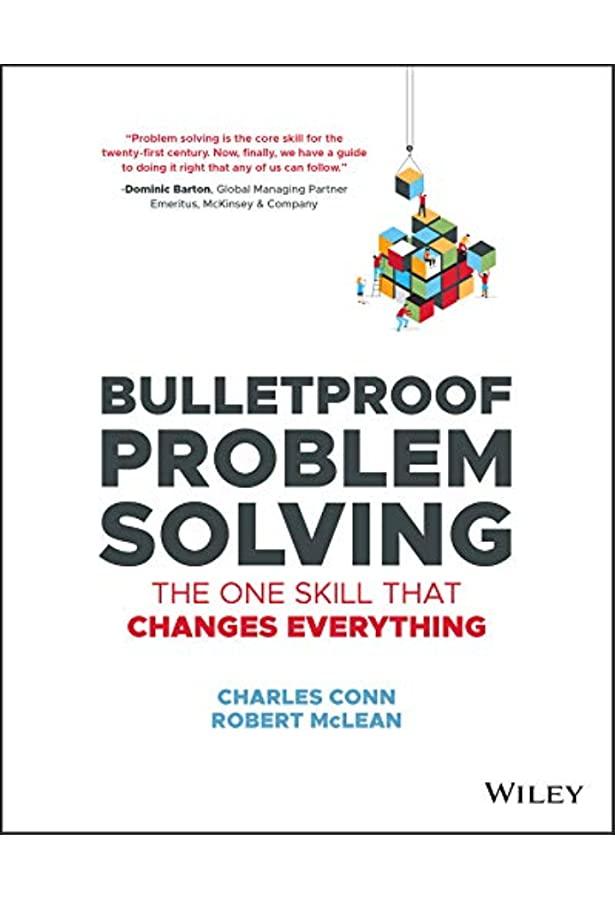Bulletproof Problem Solving by Charles Conn and Robert McLean
Share with Friends

Chapter 1: Introduction to Bulletproof Problem Solving
In this chapter, the authors introduce the concept of bulletproof problem solving, which is a systematic approach to solving problems that ensures a high probability of success. The authors argue that traditional problem-solving methods are often ineffective, as they rely on intuition and experience rather than a structured approach.
The authors provide an overview of the key concepts and techniques that are covered in the book, including the importance of defining the problem clearly, understanding the underlying causes, and using data to make decisions.
One of the best points from this chapter is the importance of defining the problem clearly. The authors quote, "A problem well-defined is a problem half-solved." This highlights the importance of taking the time to clearly understand the problem at hand before attempting to solve it.
Chapter 2: Defining the Problem
In this chapter, the authors discuss the importance of defining the problem clearly and in a way that can be understood by others. They argue that many problems are not solved effectively because they are not clearly defined, which can lead to confusion and wasted effort.
The authors also discuss the importance of understanding the underlying causes of the problem. They quote, "A problem is not just what it appears to be on the surface. It is the result of underlying causes that must be understood if the problem is to be solved."
One of the best points from this chapter is the importance of understanding the customer's perspective. The authors argue that it is important to understand the problem from the customer's point of view, as this can help to identify the underlying causes and potential solutions.
Chapter 3: Gathering Data
In this chapter, the authors discuss the importance of using data to make decisions. They argue that data can provide valuable insights into the problem and can help to identify potential solutions.
The authors also discuss the importance of using multiple sources of data, including both quantitative and qualitative data. They quote, "Data from a single source can be misleading. It is important to gather data from multiple sources to ensure that the data is reliable and accurate."
One of the best points from this chapter is the importance of using data to test assumptions. The authors argue that data can help to test assumptions and can provide valuable insights into the problem, which can help to identify potential solutions.
Chapter 4: Identifying Potential Solutions
In this chapter, the authors discuss the importance of identifying potential solutions. They argue that it is important to consider multiple solutions, as this can help to identify the best solution.
The authors also discuss the importance of evaluating the potential solutions. They quote, "It is important to evaluate the potential solutions against the criteria that are important for the problem."
One of the best points from this chapter is the importance of involving others in the solution-identification process. The authors argue that involving others can provide valuable insights into the problem and can help to identify potential solutions.
Chapter 5: Implementing the Solution
In this chapter, the authors discuss the importance of implementing the solution effectively. They argue that it is important to plan the implementation of the solution, as this can help to ensure that the solution is implemented successfully.
The authors also discuss the importance of monitoring and evaluating the solution. They quote, "It is important to monitor the solution to ensure that it is working as expected and to make any necessary adjustments."
One of the best points from this chapter is the importance of involving others in the implementation process. The authors argue that involving others can help to ensure that the solution is implemented successfully and can provide valuable insights into the problem.
In conclusion, Bulletproof Problem Solving by Charles Conn and Robert Maclean is a valuable resource for anyone looking to improve their problem-solving skills. The book provides a systematic approach to solving problems, with a focus on defining the problem clearly, understanding the underlying causes, using data to make decisions, identifying potential solutions, and implementing the solution effectively. The authors also highlight the importance of involving others in the problem-solving process, as this can provide valuable insights and help to ensure a successful outcome. Overall, the book is full of practical tips and real-world examples that make it easy to apply the concepts in your own problem-solving efforts.



























































